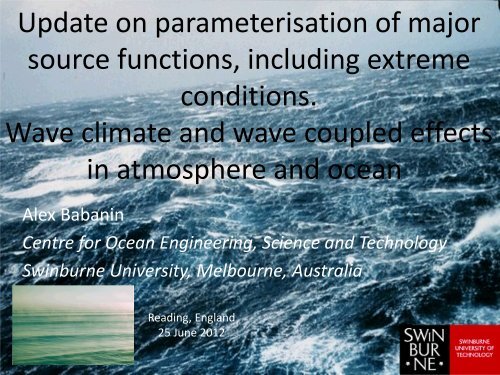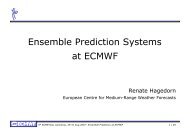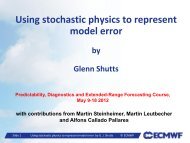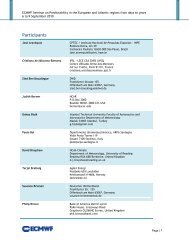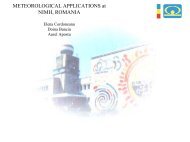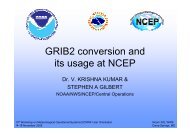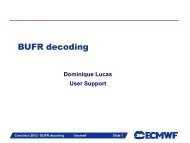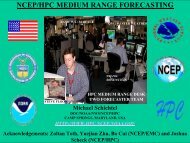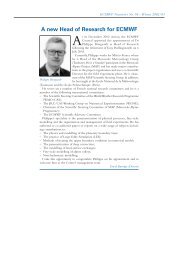Role of Ocean Waves in the Coupled Atmosphere-Ocean ... - ecmwf
Role of Ocean Waves in the Coupled Atmosphere-Ocean ... - ecmwf
Role of Ocean Waves in the Coupled Atmosphere-Ocean ... - ecmwf
You also want an ePaper? Increase the reach of your titles
YUMPU automatically turns print PDFs into web optimized ePapers that Google loves.
Update on parameterisation <strong>of</strong> major<br />
source functions, <strong>in</strong>clud<strong>in</strong>g extreme<br />
conditions.<br />
Wave climate and wave coupled effects<br />
Alex Baban<strong>in</strong><br />
<strong>in</strong> atmosphere and ocean<br />
Centre for <strong>Ocean</strong> Eng<strong>in</strong>eer<strong>in</strong>g, Science and Technology<br />
Sw<strong>in</strong>burne University, Melbourne, Australia<br />
Read<strong>in</strong>g, England<br />
25 June 2012
Fur<strong>the</strong>r Motivation<br />
<strong>Waves</strong> and wea<strong>the</strong>r, extreme wea<strong>the</strong>r,<br />
ocean circulation, climate<br />
Saturation <strong>of</strong> <strong>the</strong> sea drag<br />
Powel et al., Nature, 2003<br />
Sea surface temperature changes<br />
due to waves<br />
Ghantous and Baban<strong>in</strong>, <strong>Ocean</strong> Modell<strong>in</strong>g,<br />
submitted
W<strong>in</strong>d Input<br />
dE(<br />
k,<br />
f , �,<br />
x,<br />
t)<br />
� S<br />
dt<br />
follow<strong>in</strong>g <strong>the</strong> waves<br />
Young et al., JAOT, 2005, Donelan et al., JAOT, 2005, JPO, 2006,<br />
Baban<strong>in</strong> et al., JPO, 2007<br />
tot<br />
� S<br />
<strong>in</strong><br />
� S<br />
ds<br />
� S<br />
nl<br />
�S<br />
bf
The full separation<br />
dE(<br />
k,<br />
f , �,<br />
x,<br />
t)<br />
� S<br />
dt<br />
<strong>in</strong><br />
� S<br />
ds<br />
� S<br />
nl<br />
� S<br />
bf
The parameterisation<br />
dE(<br />
k,<br />
f , �,<br />
x,<br />
t)<br />
� S<br />
dt<br />
<strong>in</strong><br />
� S<br />
ds<br />
� S<br />
nl<br />
� S<br />
bf
Flow separation due to break<strong>in</strong>g<br />
��f) = � 0(f)(1+b T)<br />
dE(<br />
k,<br />
f , �,<br />
x,<br />
t)<br />
� S<br />
dt<br />
<strong>in</strong><br />
� S<br />
ds<br />
� S<br />
nl<br />
� S<br />
bf
W<strong>in</strong>d Input – S <strong>in</strong><br />
dE(<br />
k,<br />
f , �,<br />
x,<br />
t)<br />
� S<br />
dt<br />
Donelan, Baban<strong>in</strong>, Young and Banner (Part I, JTEC, 2005; Part II,<br />
JPO, 2006, Part III, JPO, 2007)<br />
• a new parameterisation <strong>of</strong> <strong>the</strong> w<strong>in</strong>d <strong>in</strong>put function, based on field<br />
measurements, is suggested.<br />
• <strong>the</strong> parameterisation <strong>in</strong>cludes very strongly forced and steep wave<br />
conditions, <strong>the</strong> w<strong>in</strong>d <strong>in</strong>put for which has never before been directly<br />
measured <strong>in</strong> field conditions.<br />
• new physical features <strong>of</strong> air-sea exchange have been found:<br />
- full separation <strong>of</strong> <strong>the</strong> air flow at strong w<strong>in</strong>d over steep waves<br />
- leads to <strong>the</strong> sea drag saturation<br />
- <strong>the</strong> exchange mechanism is non-l<strong>in</strong>ear and depends on <strong>the</strong><br />
wave steepness<br />
- enhancement <strong>of</strong> <strong>the</strong> w<strong>in</strong>d <strong>in</strong>put over break<strong>in</strong>g waves<br />
<strong>in</strong><br />
� S<br />
ds<br />
� S<br />
nl<br />
� S<br />
bf
Break<strong>in</strong>g Dissipation S ds<br />
dE(<br />
k,<br />
f , �,<br />
x,<br />
t)<br />
� S<br />
dt<br />
two passive acoustic methods to study spectral dissipation<br />
- segment<strong>in</strong>g a record <strong>in</strong>to break<strong>in</strong>g and non-break<strong>in</strong>g segments<br />
- us<strong>in</strong>g acoustic signatures <strong>of</strong> <strong>in</strong>dividual bubble-formation events<br />
<strong>in</strong><br />
� S<br />
ds<br />
� S<br />
nl<br />
� S<br />
bf
Whitecapp<strong>in</strong>g Dissipation S ds<br />
dE(<br />
k,<br />
f , �,<br />
x,<br />
t)<br />
� S<br />
dt<br />
<strong>in</strong><br />
� S<br />
ds<br />
� S<br />
nl
White Cap Dissipation S ds<br />
1) Segment<strong>in</strong>g <strong>the</strong> record<br />
Directional dissipation<br />
f p<br />
dE(<br />
k,<br />
f , �,<br />
x,<br />
t)<br />
� S<br />
dt<br />
f p<br />
2f p<br />
<strong>in</strong><br />
� S<br />
ds<br />
� S<br />
nl
White Cap Dissipation S ds<br />
2) Individual bubble formation<br />
frequency distribution <strong>of</strong> break<strong>in</strong>g probability b T<br />
- L<strong>in</strong>ear dependence at <strong>the</strong> peak<br />
- Cumulative effect at small scales<br />
- Direct dependence on <strong>the</strong> w<strong>in</strong>d at strong forc<strong>in</strong>g<br />
dE(<br />
k,<br />
f , �,<br />
x,<br />
t)<br />
� S<br />
dt<br />
<strong>in</strong><br />
� S<br />
ds<br />
� S<br />
nl
White Cap Dissipation S ds<br />
dE(<br />
k,<br />
f , �,<br />
x,<br />
t)<br />
� S<br />
dt<br />
• spectral dissipation was approached by two <strong>in</strong>dependent means<br />
based on passive acoustic methods<br />
• if <strong>the</strong> wave energy dissipation at each frequency were due to<br />
whitecapp<strong>in</strong>g only, it should be a function <strong>of</strong> <strong>the</strong> excess <strong>of</strong> <strong>the</strong><br />
spectral density above a dimensionless threshold spectral level,<br />
below which no break<strong>in</strong>g occurs at this frequency. This was found to<br />
be <strong>the</strong> case around <strong>the</strong> wave spectral peak. dom<strong>in</strong>ant break<strong>in</strong>g<br />
• dissipation at a particular frequency above <strong>the</strong> peak demonstrates<br />
a cumulative effect, depend<strong>in</strong>g on <strong>the</strong> rates <strong>of</strong> spectral dissipation<br />
at lower frequencies<br />
S ( f ) � a � f ( F(<br />
f ) � F ( f )) A(<br />
f ) � b ( F(<br />
g)<br />
� F ( g))<br />
A(<br />
g)<br />
dg<br />
ds<br />
• dimensionless saturation threshold value <strong>of</strong><br />
thr<br />
should be used to obta<strong>in</strong> <strong>the</strong> dimensional spectral threshold F thr(f) at<br />
each frequency f<br />
• dependence on <strong>the</strong> w<strong>in</strong>d at strong w<strong>in</strong>d forc<strong>in</strong>g<br />
f<br />
�<br />
f<br />
p<br />
thr<br />
<strong>in</strong><br />
� S<br />
ds<br />
� S<br />
nl<br />
� thr( f ) � 0.035<br />
� S<br />
bf
Balance <strong>of</strong> dissipation <strong>in</strong> <strong>the</strong> water<br />
column and <strong>the</strong> w<strong>in</strong>d <strong>in</strong>put<br />
�<br />
( z)<br />
�<br />
�const<br />
� �1<br />
� z<br />
� � 2<br />
� z<br />
dE(<br />
k,<br />
f , �,<br />
x,<br />
t)<br />
� S<br />
dt<br />
z<br />
z<br />
z<br />
�<br />
�<br />
�<br />
0.<br />
4<br />
0.<br />
4<br />
0.<br />
4<br />
H<br />
H<br />
H<br />
s<br />
s<br />
s<br />
U<br />
U<br />
<strong>in</strong><br />
� S<br />
�<br />
�<br />
� 7.<br />
5�<br />
� 7.<br />
5�<br />
�<br />
ds<br />
� S<br />
nl
The approach<br />
• Traditional approach (ie. Komen et al. (1984)): reproduce known<br />
growth curves – i.e. model <strong>the</strong> balance <strong>of</strong> <strong>the</strong> source functions<br />
ra<strong>the</strong>r than <strong>the</strong> functions <strong>the</strong>mselves<br />
• Constra<strong>in</strong>t approach: follow<strong>in</strong>g suggestion at WISE-2004 (Read<strong>in</strong>g,<br />
England) by Mark Donelan<br />
• Ma<strong>in</strong> constra<strong>in</strong>t: <strong>in</strong>tegral w<strong>in</strong>d momentum <strong>in</strong>put must be equal to<br />
<strong>the</strong> total stress less viscous stress:<br />
f<br />
�<br />
�<br />
0<br />
f<br />
�<br />
m k<br />
S<strong>in</strong> ( f ) df � � S<strong>in</strong><br />
( f ) df � �<br />
�<br />
• experimental dependencies for total stress and viscous stress<br />
are used<br />
• experimental dependencies for ratio ot total <strong>in</strong>put and total<br />
dissipation are used<br />
f<br />
�<br />
�<br />
0<br />
S<br />
ds<br />
( f ) df<br />
0<br />
�<br />
f<br />
�<br />
�<br />
0<br />
S<br />
<strong>in</strong><br />
( f ) df<br />
w
<strong>Waves</strong> and air-sea <strong>in</strong>teractions<br />
• <strong>in</strong> air-sea <strong>in</strong>teraction and ocean-mix<strong>in</strong>g models, <strong>the</strong><br />
w<strong>in</strong>d stress is usually parameterised to directly drive<br />
<strong>the</strong> dynamics <strong>of</strong> <strong>the</strong> upper ocean<br />
• ~90% <strong>of</strong> <strong>the</strong> flux, however, first <strong>in</strong>put <strong>in</strong>to <strong>the</strong> waves<br />
• air-sea coupl<strong>in</strong>g is usually parameterised <strong>in</strong> terms <strong>of</strong><br />
<strong>the</strong> drag coefficient C d<br />
� � � �<br />
u<br />
2<br />
� C<br />
a * a d<br />
• <strong>the</strong> parameterisation relies on <strong>the</strong> concept <strong>of</strong> <strong>the</strong> constant flux<br />
layer<br />
• C d is rout<strong>in</strong>ely parameterised <strong>in</strong> terms <strong>of</strong> w<strong>in</strong>d speed U 10<br />
U<br />
2<br />
10<br />
• scatter has not improved over some 30 years<br />
• coupl<strong>in</strong>g with wave models is necessary
Gust<strong>in</strong>ess
Dependence<br />
on break<strong>in</strong>g<br />
Baban<strong>in</strong>, 2011<br />
Break<strong>in</strong>g and Directional<br />
Spread<strong>in</strong>g<br />
Dependence on directional spread<strong>in</strong>g<br />
T<strong>in</strong>g et al., JGR, <strong>in</strong> press<br />
K(U/c p,f,µ)=A(U/c p,f)cos 2s(U/cp,f)(µ-µ 0/2)<br />
U/c p= 1, 3, 5
T<strong>of</strong>foli et al., JGR, <strong>in</strong> press<br />
Humidity<br />
Based on Lake George data, C D versus humidity
W<strong>in</strong>d Input and W<strong>in</strong>d Stress<br />
� �<br />
� �<br />
u<br />
2<br />
� C<br />
a * a d<br />
U<br />
2<br />
10<br />
Turbulent fluxes are not constant <strong>in</strong> WBL
W<strong>in</strong>d: What do we need most?<br />
• Directional distribution <strong>of</strong> <strong>the</strong> w<strong>in</strong>d <strong>in</strong>put<br />
• Fluxes: momentum flux, heat flux, moisture,<br />
spray<br />
• Surface stress versus mean w<strong>in</strong>d speed<br />
elevated<br />
• Advanced sea-drag parameterisations
White Cap Dissipation S ds<br />
2) Individual bubble formation<br />
bubble size is related to <strong>the</strong> break<strong>in</strong>g severity<br />
dE(<br />
k,<br />
f , �,<br />
x,<br />
t)<br />
� S<br />
dt<br />
<strong>in</strong><br />
� S<br />
ds<br />
� S<br />
nl
Dissipation: what do we need most?<br />
• More direct measurements <strong>of</strong> <strong>the</strong> dissipation rates<br />
across <strong>the</strong> spectrum<br />
• Measurements and parameterisation <strong>of</strong> <strong>the</strong> break<strong>in</strong>g<br />
severity<br />
• Whitecapp<strong>in</strong>g coverage versus break<strong>in</strong>g severity<br />
• Dependence <strong>of</strong> <strong>the</strong> whitecapp<strong>in</strong>g coveraged<br />
environmental properties, i.e. w<strong>in</strong>d, wave age,<br />
surface temperature, biological surfactants etc.<br />
• Directional distribution <strong>of</strong> <strong>the</strong> dissipation
Air-sea <strong>in</strong>teractions at extreme w<strong>in</strong>d forc<strong>in</strong>g<br />
• At w<strong>in</strong>d speeds<br />
U>32m/s<br />
dynamics <strong>of</strong> <strong>the</strong> atmospheric boundary layer, <strong>of</strong> <strong>the</strong> ocean<br />
wave surface and <strong>of</strong> <strong>the</strong> upper ocean layer – all change<br />
• Strong correlation <strong>of</strong> wave asymmetry As with w<strong>in</strong>d forc<strong>in</strong>g,<br />
asymmetry saturates (Leik<strong>in</strong> et al., 1995, NPG) at<br />
U10~34m/s Change <strong>of</strong> <strong>the</strong> wave break<strong>in</strong>g mechanism to, perhaps, break<strong>in</strong>g due<br />
to direct w<strong>in</strong>d forc<strong>in</strong>g<br />
• Drag saturates (Powel et al., 2003, Nature) at<br />
U10=32-33m/s • additional mechanism <strong>of</strong> air <strong>in</strong>jection due to bubbles <strong>of</strong> 1mm<br />
diameter transported down to 20m below <strong>the</strong> surface and<br />
dissolved due to <strong>the</strong> hydrostatic compression (McNeil & D’Asaro,<br />
2007, J. Mar. Scie.) at<br />
U10 > 35m/s
Tropical Cyclone Yasi – setup & observations<br />
wave data<br />
w<strong>in</strong>d data<br />
best track<br />
altimeter<br />
tracks<br />
1600x2000km
Yasi – along-track comparison<br />
• deep water track: ENVISAT – 1 Feb 23:36 UTC<br />
• w<strong>in</strong>ds (top) and wave height (bottom)
Yasi – <strong>in</strong> situ waves<br />
• observed waves next to Townsville (ADCP) and Cape Cleveland<br />
(DERM) for all three w<strong>in</strong>d fields
Baban<strong>in</strong>, A.V., T.-W. Hsu, A. Roland, S.-H. Ou, D.-J. Doong, and Y.-M. Fan,<br />
2010: Spectral modell<strong>in</strong>g <strong>of</strong> Typhoon Krosa, Natural Hazards and<br />
Earth System Sciences, 2011<br />
• highest ever waves are<br />
measured <strong>of</strong>f <strong>the</strong> coast<br />
<strong>of</strong> Taiwan<br />
• spectral models cannot<br />
reproduce <strong>the</strong>m<br />
• <strong>the</strong> only property <strong>the</strong><br />
wave height responds <strong>in</strong><br />
<strong>the</strong> models – is <strong>the</strong><br />
bottom-<strong>in</strong>duced<br />
break<strong>in</strong>g formulation
What we need<br />
• At w<strong>in</strong>d speeds<br />
U>32m/s<br />
dynamics <strong>of</strong> <strong>the</strong> atmospheric boundary layer, <strong>of</strong> <strong>the</strong><br />
ocean wave surface and <strong>of</strong> <strong>the</strong> upper ocean layer<br />
– all change<br />
• Details are vague, physics is unknown<br />
• Any field observations are helpful: fluxes, sea<br />
drag, wave spectra and wave statistics,<br />
whitecapp<strong>in</strong>g and dissipation, bottom-<strong>in</strong>duced<br />
break<strong>in</strong>g <strong>of</strong> extreme waves
Swell attenuation due to wave<br />
turbulence<br />
3.<br />
0�1.<br />
0<br />
� � 300�<br />
a<br />
b1=0.004 Dissipation<br />
• volumetric<br />
• per unit <strong>of</strong><br />
surface<br />
• per unit <strong>of</strong><br />
propagation<br />
distance
1=0.004<br />
asterisks<br />
Swell attenuation due to wave<br />
turbulence<br />
b 1=0.002<br />
circles
W<strong>in</strong>d/Wave Climate
W<strong>in</strong>d and waves as climate <strong>in</strong>dicators<br />
Young et al., Science, 2011
W<strong>in</strong>d Trends, by SSM/I
W<strong>in</strong>d Trends, by SSM/I
W<strong>in</strong>d Trends, by SSM/I
Summary<br />
> wave physics, what is needed<br />
– perhaps, 4 physics: swell, light w<strong>in</strong>ds, moderate w<strong>in</strong>ds, extreme<br />
– long-term observations, statistics, e.g. freak waves<br />
– w<strong>in</strong>d stress, sea drag, fluxes across <strong>in</strong>terface<br />
– wave dissipation, <strong>in</strong>clud<strong>in</strong>g swell, <strong>in</strong>teraction with bottom,<br />
currents<br />
– directional distributions <strong>of</strong> energy sources/s<strong>in</strong>ks<br />
– extreme conditions, tropical cyclones<br />
> waves provide feedback<br />
– to <strong>the</strong> atmospheric boundary layer<br />
– to <strong>the</strong> upper ocean (usually overlooked)<br />
– to <strong>the</strong> large-scale air-sea <strong>in</strong>teractions<br />
– to wea<strong>the</strong>r, ocean circulation and climate<br />
> Wave/w<strong>in</strong>d climate also changes<br />
- waves can serve as a climate <strong>in</strong>dicator, gradual and non-uniform<br />
36
● Numerical<br />
Modell<strong>in</strong>g<br />
● Sediment<br />
Mobility<br />
● Roughness –<br />
Bedforms &<br />
Sediment<br />
Gra<strong>in</strong> Size<br />
● Sediment<br />
Suspension<br />
● Sediment<br />
Transport<br />
● Conclusions<br />
Bedforms: Sand Ripples<br />
• Ripples can occur under certa<strong>in</strong> conditions<br />
that are determ<strong>in</strong>ed by Nielsen (1992)<br />
• Ripples create a higher friction coefficient<br />
• Can be determ<strong>in</strong>ed empirically by us<strong>in</strong>g <strong>the</strong><br />
follow<strong>in</strong>g parameters:<br />
– Orbital Velocity at seabed<br />
– Excursion amplitude at seabed<br />
– Gra<strong>in</strong> Size<br />
– Specific Gravity
Swan Output<br />
Accuracy – Time Series & Scatter Plot<br />
Significant Wave Height (Green = Observed Data, Blue = Modeled Data)<br />
Observed Data
● Numerical<br />
Modell<strong>in</strong>g<br />
● Sediment<br />
Mobility<br />
● Roughness –<br />
Bedforms &<br />
Sediment<br />
Gra<strong>in</strong> Size<br />
● Sediment<br />
Suspension<br />
● Sediment<br />
Transport<br />
● Conclusions<br />
What if ripples don’t occur?<br />
• No ripples occur when conditions too<br />
low <strong>in</strong> energy (seabed isn’t mobile)<br />
• Ripples get washed out dur<strong>in</strong>g large<br />
storm events<br />
• Roughness dependent on gra<strong>in</strong> size only<br />
• Test case: Lakes Entrance, Lake George
Conclusions<br />
► The SWAN wave model was modified to <strong>in</strong>clude an<br />
additional friction rout<strong>in</strong>e to evaluate roughness due to<br />
ripples.<br />
► Increased dissipation due to bottom friction from<br />
ripple bedforms had a positive effect on <strong>the</strong> accuracy<br />
<strong>of</strong> modell<strong>in</strong>g shallow depths with <strong>the</strong> existence <strong>of</strong><br />
ripples.<br />
► Roughness due to gra<strong>in</strong> size also provided an<br />
acceptable roughness coefficient <strong>in</strong> <strong>the</strong> absence <strong>of</strong><br />
ripples.
Motivation<br />
Propagation <strong>of</strong> waves through spatially and temporally<br />
variable currents is a frequent occurrence <strong>in</strong> coastal areas<br />
Port Phillip, Australia<br />
Wadden Sea, Holland<br />
navigation coastal defense<br />
<strong>Waves</strong> on currents is perhaps <strong>the</strong> last loose physics <strong>in</strong> wave<br />
forecast models
Measurements, adverse currents<br />
stronger velocity gradients, U>c g/4<br />
gradual irreversible downshift<br />
beyond lower sideband<br />
• waves propagate from right to left<br />
• circles signify downshift<strong>in</strong>g observed, dashed l<strong>in</strong>e <strong>the</strong> sideband<br />
• probes 7-5 are over <strong>the</strong> bottom elevation<br />
gc<br />
Shoal top
Young, I.R., Baban<strong>in</strong>, A.V., Stiassnie, M.A., Greenslade, D.J. (Australian<br />
Bureau <strong>of</strong> Meteorology), “Numerical modell<strong>in</strong>g <strong>of</strong> extreme waves<br />
generated by tropical cyclones”, Australian Research Council,<br />
Discovery Grant, 2010-2012<br />
Young, 2006, J. Geophys. Res.<br />
new S nl term is to be developed
Dissipation Sds dE(<br />
k,<br />
f , �,<br />
x,<br />
t)<br />
� S<strong>in</strong><br />
� Sds<br />
� Snl<br />
� The <strong>in</strong>duced dissipation can be caused by forced break<strong>in</strong>g <strong>of</strong> shorter waves due<br />
to <strong>the</strong> dom<strong>in</strong>ant break<strong>in</strong>g, or modulation <strong>of</strong> short waves by longer waves, or by<br />
enhanced turbulent viscosity due to <strong>the</strong> dom<strong>in</strong>ant break<strong>in</strong>g, or both.<br />
S ( f ) � a � f ( F(<br />
f ) � F ( f )) A(<br />
f ) � b ( F(<br />
g)<br />
� F ( g))<br />
A(<br />
g)<br />
dg<br />
ds<br />
thr<br />
f<br />
�<br />
f<br />
p<br />
dt<br />
� importance <strong>of</strong> <strong>the</strong> cumulative<br />
dissipation is evident<br />
thr
Cyclone Wave Modell<strong>in</strong>g<br />
• Change <strong>of</strong> <strong>the</strong> physical regime at extreme w<strong>in</strong>ds<br />
• Cyclone Yasi<br />
• Typhoon Krosa
Saturation <strong>of</strong> Sea Drag<br />
Powel et al., 2003, Nature<br />
• Extensive research field s<strong>in</strong>ce<br />
2003, dozens <strong>of</strong> papers<br />
• field and laboratory<br />
experiments<br />
• <strong>the</strong>ories:<br />
- spray <strong>the</strong>ories, 4 classes<br />
- hydrodynamic <strong>the</strong>ories, 2<br />
classes<br />
- <strong>in</strong>stability <strong>of</strong> ripples (KH and<br />
modulat<strong>in</strong>al)<br />
-turbulence <strong>the</strong>ory: 2D<br />
turbulence suppresses 3D<br />
vortexes<br />
- comb<strong>in</strong>ation <strong>of</strong> those<br />
Drag saturates at<br />
U 10=32-33m/s
Shats, M., Baban<strong>in</strong>, A.V., Marusic, I., Young, I.R., Punzmann, H., Xia, H,<br />
T<strong>of</strong>foli, A., Chalikov, D., Klewicki, J., Hutch<strong>in</strong>gs, N., Monti, J., “W<strong>in</strong>d pr<strong>of</strong>iler<br />
network for planetary boundary layer research”, , Australian Research<br />
Council, Large Equipment and Infrastructure Facilities Grant, 2012
Wave asymmetry at<br />
extreme w<strong>in</strong>d forc<strong>in</strong>g<br />
• Leik<strong>in</strong> et al., 1995, Nonl<strong>in</strong>ear Proc. Geophys., laboratory<br />
experiment with w<strong>in</strong>d-forced waves<br />
• Strong correlation <strong>of</strong> asymmetry A s with w<strong>in</strong>d forc<strong>in</strong>g, no<br />
correlation for skewness and steepness<br />
• Broad range <strong>of</strong> u * which converts <strong>in</strong>to U 10=8-48m/s<br />
• Asymmetry saturates at u */c p~1.2, i.e. at<br />
U 10~34m/s<br />
• This <strong>in</strong>dicates change <strong>of</strong> <strong>the</strong> wave break<strong>in</strong>g mechanism<br />
to, perhaps, break<strong>in</strong>g due to direct w<strong>in</strong>d forc<strong>in</strong>g
Air-Sea Gas Exchanges <strong>in</strong> Extreme<br />
Conditions<br />
• McNeil & D’Asaro, 2007, J. Mar. Scie.<br />
• cross-<strong>in</strong>terface gas fluxes measured dur<strong>in</strong>g<br />
Hurricane Frances <strong>in</strong> 2004<br />
• U 10 up to 55m/s<br />
• fluxes still grow, but at a slow rate if<br />
U 10 > 35m/s<br />
• additional mechanism <strong>of</strong> air <strong>in</strong>jection due to<br />
bubbles <strong>of</strong> 1mm diameter transported down to<br />
20m below <strong>the</strong> surface and dissolved due to <strong>the</strong><br />
hydrostatic compression
Yasi – <strong>in</strong>ner grid<br />
• DOUBLE HOLLAND parametric w<strong>in</strong>ds (left) and<br />
WRF w<strong>in</strong>ds (right) for 2 Feb 2011 10:00UTC
Yasi – <strong>in</strong>ner grid<br />
• wave height from DOUBLE HOLLAND parametric<br />
w<strong>in</strong>ds (left) and WRF w<strong>in</strong>ds (right) for 2 Feb<br />
2011 10:00UTC
Baban<strong>in</strong>, GRL, 2006<br />
Hypo<strong>the</strong>sis <strong>of</strong> <strong>the</strong> Wave<br />
Reynolds Number<br />
η(x,t) = a 0cos(ωt+kx)<br />
a(z) = a 0exp(-kz)<br />
It is <strong>the</strong> hypo<strong>the</strong>sis that <strong>the</strong> a-based Reynolds number<br />
2<br />
aV a �<br />
Re � �<br />
� �<br />
where V=ωa is orbital velocity, and ν is k<strong>in</strong>ematic viscosity <strong>of</strong> <strong>the</strong> ocean water,<br />
<strong>in</strong>dicates transition from lam<strong>in</strong>ar orbital motion to turbulent<br />
Critical Reynolds Number for <strong>the</strong> Wave-Induced<br />
Motion, and Depth <strong>of</strong> <strong>the</strong> Mixed Layer<br />
�<br />
Re( z)<br />
� a<br />
�<br />
2<br />
0<br />
�<br />
exp( �2kz)<br />
� a<br />
�<br />
2<br />
0<br />
�<br />
exp( �2<br />
g<br />
2<br />
1 Re cr � g a0�<br />
zcr � � ln( ) � ln( )<br />
2<br />
2<br />
2k<br />
a � 2�<br />
Re �<br />
0<br />
cr<br />
2<br />
z)<br />
Re cr=3000
Potential role <strong>of</strong> <strong>the</strong> wave-<strong>in</strong>duced mix<strong>in</strong>g<br />
Baban<strong>in</strong> et al., 2009, <strong>Ocean</strong> Modell<strong>in</strong>g<br />
Wave turbulence<br />
Langmuir circulation<br />
H L=4U 2 10/g
Dai et al., JPO, 2010<br />
no waves<br />
time scale: hours<br />
Laboratory Experiment <strong>in</strong> <strong>the</strong> First<br />
Inst. <strong>of</strong> <strong>Ocean</strong>ography, Ch<strong>in</strong>a<br />
Mix<strong>in</strong>g <strong>the</strong> stratified fluid<br />
experiment (left), model (right)<br />
non-break<strong>in</strong>g waves<br />
time scale: m<strong>in</strong>utes
Laboratory Experiment at ASIST, RSMAS,<br />
University <strong>of</strong> Miami<br />
turbulence is highly <strong>in</strong>termittent, most frequent at rear wave face<br />
� � 300�<br />
a<br />
3.<br />
0<br />
�<br />
1.<br />
0<br />
This is close to <strong>the</strong><br />
expectation: s<strong>in</strong>ce <strong>the</strong><br />
force due to <strong>the</strong><br />
turbulent stresses is<br />
proportional to a 2 , <strong>the</strong><br />
energy dissipation rate<br />
should be ~a 3 .<br />
Baban<strong>in</strong> and Haus, 2009
Baban<strong>in</strong> & Chalikov, JGR, submitted<br />
Model <strong>of</strong> generation <strong>of</strong><br />
turbulence by nonl<strong>in</strong>ear waves<br />
Model is based on exact 2-D (x-z) model <strong>of</strong> surface waves coupled<br />
with 3-D LES (x-y-z) model <strong>of</strong> vortical motion based on Reynolds<br />
equation with parameterised subgrid turbulence.
�K<br />
�T<br />
s<br />
mean<br />
�U<br />
i<br />
CURR<br />
�K<br />
�X<br />
i<br />
t<br />
�<br />
P � P � � M<br />
M � �ui<br />
/ �<br />
x<br />
j<br />
D<br />
TKE evolution equation<br />
TKE production<br />
shear frequency<br />
K<br />
� P<br />
2<br />
CURR<br />
P � ( � ��<br />
)( M � M<br />
s<br />
CURR<br />
Pleskachevski et al., JPO, 2010<br />
wave<br />
Field observations, North Sea,<br />
sediment suspension<br />
S<br />
� G � E<br />
2 AM 2<br />
CURR wave<br />
)<br />
K
T<strong>of</strong>foli et al., JGR, submitted<br />
Field observations, North Rank<strong>in</strong><br />
mixed layer deepen<strong>in</strong>g<br />
Wave height<br />
MLD:<br />
dark – wave <strong>in</strong>duced<br />
grey - measured
Ghantous et al., <strong>Ocean</strong> Modell<strong>in</strong>g, submitted<br />
Modell<strong>in</strong>g SST and MLD at <strong>the</strong> scale <strong>of</strong><br />
tropical cyclone
Implement<strong>in</strong>g wave-<strong>in</strong>duced mix<strong>in</strong>g <strong>in</strong> CLIMBER<br />
• Seasonal trend <strong>of</strong> <strong>the</strong> global<br />
zonally averaged SST. Panels shown:<br />
25, 35, 45 and 55 degrees North<br />
(from top to bottom). L<strong>in</strong>es shown:<br />
default version <strong>of</strong> CLIMBER (blue),<br />
variable MLD (red) and observations<br />
based on Levitus data (black).<br />
• effect is essential outside <strong>the</strong><br />
tropical areas<br />
• both magnitudes and phases <strong>of</strong><br />
SST are imporved
Implement<strong>in</strong>g wave-<strong>in</strong>duced mix<strong>in</strong>g <strong>in</strong> CLIMBER<br />
Global distribution ( Nor<strong>the</strong>rn<br />
summer)<br />
• temperature (degrees)<br />
• pressure (mbar)<br />
• precipitation (mm per day)
Wave-Induced Turbulence <strong>in</strong> ocean models<br />
Qiao et al., 2010, <strong>Ocean</strong> Dynamics<br />
Correlation coefficients between <strong>the</strong> model outcomes and <strong>the</strong> World <strong>Ocean</strong> Atlas for vertical<br />
temperature distributions at 35N latitude (darker areas correspond to higher correlation. The left<br />
panel demonstrates <strong>the</strong> transect across <strong>the</strong> Pacific (left) and Atlantic (right) oceans without wave<strong>in</strong>duced<br />
turbulent stresses accounted for, and <strong>the</strong> right panel – with <strong>the</strong> respective Reynolds stresses<br />
added.
Qiao at al., 2010 Globally averaged SST<br />
Upper 100m globally averaged<br />
ROMS 0.62-0.79<br />
POM 0.58-0.76<br />
0.68 0.93<br />
Much Improved except tropical area
Motivation<br />
<strong>Waves</strong> <strong>in</strong>fluences <strong>the</strong> climate, climate affects<br />
<strong>the</strong> waves<br />
W<strong>in</strong>ds and waves change<br />
Observations<br />
Young et al., Science, 2011<br />
Sea surface temperature changes due to<br />
waves<br />
Model<br />
MLD , Sou<strong>the</strong>rn<br />
Pacific <strong>in</strong> Feb.<br />
MLD, Nor<strong>the</strong>rn<br />
Atlantic <strong>in</strong> Aug<br />
Qiao et al., <strong>Ocean</strong> Dynamics, 2010<br />
With<br />
waves<br />
Without<br />
waves<br />
World <strong>Ocean</strong><br />
Atlas


